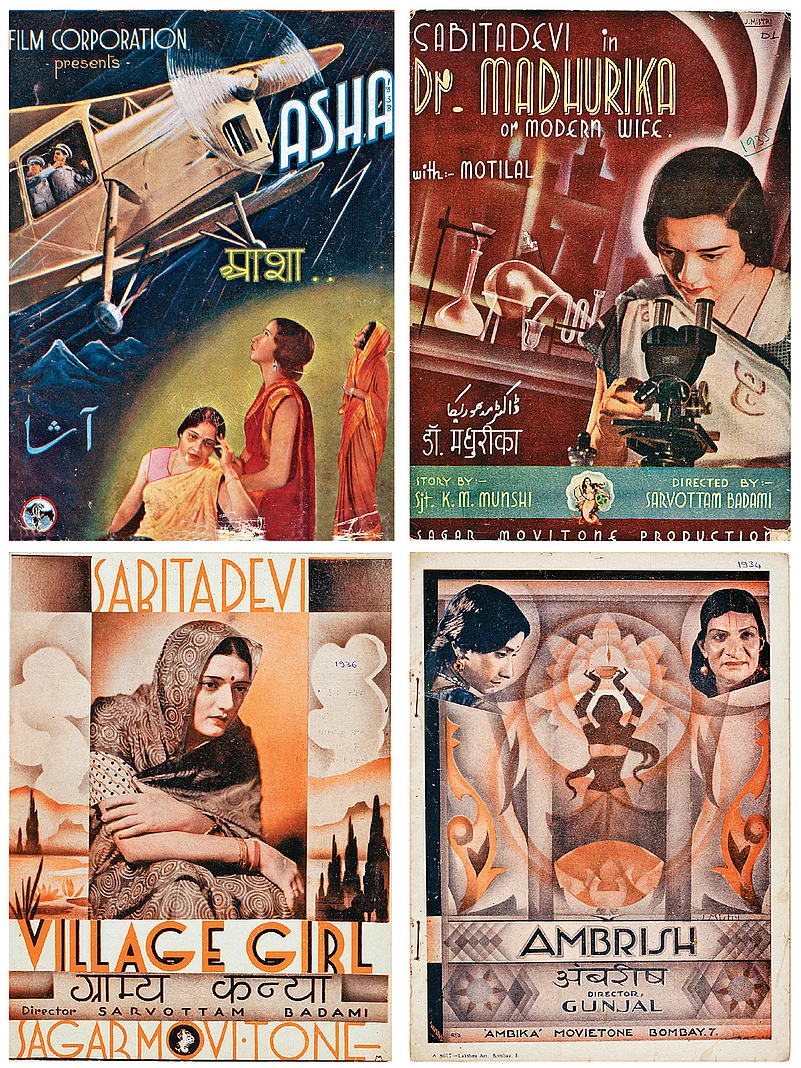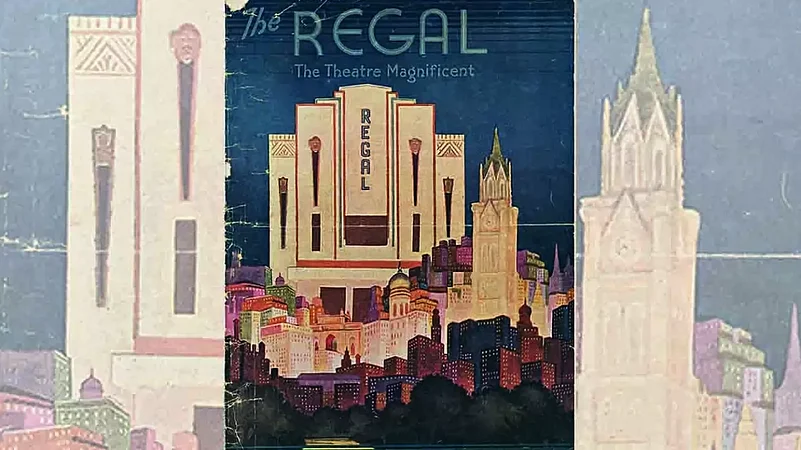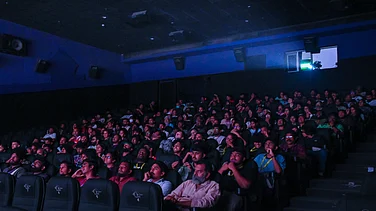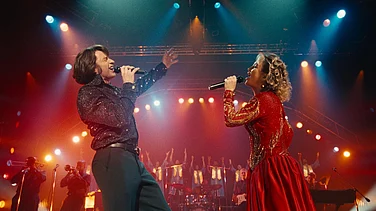His signature keeps changing over the years. Sometimes it appears plainly in letterspaced capitals, J. M I S T R I. At others, the top bar of the J takes flight like a bird, or the M becomes a monogram towering above the other letters. Always, the mark is an integral part of the layout, a complement to the images of glamorous stars and silhouetted dancers, the complex patterns and elongated lettering of his publicity designs.
True to his name, the designer himself is something of a mystery. Despite the ubiquity of their entertaining images, publicity artists are seldom famous figures in Indian cinema, and as a name from the distant 1930s, Mistri is perhaps even more obscure than most. What makes him worth remembering is his body of work, which shows an individual approach to design and typography startlingly at variance with standard Hindi film imagery. Even more remarkably, these images are in the most advanced design style of their time: Art Deco.
Who was J. Mistri, and what made him a messenger of the modern in 1930s India? For an answer, one must turn to the history of Art Deco in India. Design histories have it that Art Deco made its debut in 1925 at a Paris exposition and quickly became a global rage. Its knotted symmetries and streamlined curves, its zigzags and ziggurats, constituted a visual language that symbolised all the excitement and promise of the future, and was therefore, as Steven Heller puts it, “equally appropriate in the service of electrical appliances or despotic regimes”. From skyscrapers and jewellery to opulent furnishings, the Deco influence was soon to be seen everywhere.
In many ways, it was cinema that spread the message of Deco across the world. Hollywood discovered the style at its very inception, and deployed it in Jazz Age films, such as Our Dancing Daughters (1928). The glittering costumes and gleaming sets spun a myth of glamour and modernity that spoke to the mass audience’s desires for upward mobility. Through Deco, Hollywood studios discovered the relationship between movies and consumerism, the fact that their products could double as screen catalogues for luxury goods and fashions. In the words of Hollywood czar, Will Hays, there was a ‘definite advertising value in every foot of American film’: movies could sell anything, even ‘bathtubs to the heathen Chinee.’
The heathen Hindoo was not left out of Hollywood’s strategies either. In India, Deco had first arrived as a sophisticated architectural style patronised by princes and wealthy industrialists for its cosmopolitan associations. It was a steady supply of Hollywood movies, however, that made the style more widely known in the Indian metropolis. It is no coincidence that one of the first public articulations of Art Deco in India was Bombay’s Regal Cinema, which brought the American movie-going experience to the city’s consuming classes. Conceived in an ‘advanced modernistic style’, its interiors featured cubist motifs designed by the Czech artist, Karl Schara. Other Deco cinemas followed, decorated by expatriate designers working for upmarket firms that catered to Bombay’s aspirations for luxurious modern living. Then, in 1938, MGM brought in the real deal with Metro cinemas in Bombay and Calcutta, built on the lines of icture palaces in the US.
Influential as they were, these Deco splendours were patronised mainly by colonial and Indian elites and excluded much of the Indian public. It was not till Hindi cinema joined the Deco bandwagon that the movie-going masses discovered the modern style in a considerably transmuted form. With the coming of the talkies in 1931, large studios were set up to capitalise on the surging demand for Indian films. In a bid to project themselves as modern, progressive institutions, they often turned to Deco as a visual style. The usage was sometimes derivative, as in the stylings of Hamari Betiyan aka Our Darling Daughters (1936) and sometimes inspired, as in the white palace set in Amar Jyoti (1936), a minimalist triumph from the art director Fattelal.
Apart from the movies themselves, film publicity introduced Indian audiences to the modern look too. Among the publicity designers of the 30s, J. Mistri was the most forward-looking, churning out both glamorous images with a Hollywood feel and less conventional explorations. In my book The Art of Bollywood (2010), I hazarded the guess he was Jagmohan Mistri, a publicity artist working at Sagar Movietone in 1938. Since then, I have discovered evidence of him running his own art studio out of the Bombay suburb of Santa Cruz in 1933. In an advertisement issued that year, Mistri described himself as a highly experienced ‘Business Architect with the training of an Artist’, explaining that just as an architect uses his expertise to build homes, a designer, too, applies his training to develop businesses—a task which must be done ‘more thoroughly than building a house’.
Given the nascent state of Indian commercial art studios in 1933, this was quite a novel and evolved pitch. Mistri’s designs for prestigious productions such as Indira M.A. (1934) and Dr Madhurika (1935) show that his claims were reasonably well-founded. His execution can be hit-or-miss but, generally, there is a design sensibility at work and a clear strategy to his choices. While he has no set style, he leans towards tightly constructed collages featuring retouched photographs, symbolic motifs, abstract patterns, scapes and backgrounds, occasionally rendered cubistically and accompanied by stacked layers of lettering in Roman and Devanagari. Many of these diverse elements come together quite strikingly in Mistry’s geometrically organised layouts for Shaher ka Jadoo (1934) and Grama Kanya (1936).
Mistri was not alone in exploring the possibilities of the modern style. Under US influence, Indian film publicity had started featuring dynamic, collaged visuals in the silent period, and Deco crept in as early as 1930-1931. Several designers of the 30s such as S K Murthy, J.B Dikshit and Chandavarkar used a generalised Deco vocabulary in their work: the familiar searchlight and sunburst motifs, echo effects and radial arrangements all make an appearance. The Deco influence was strongest in the typography, especially the Devanagari lettering, where staid, Balbodh forms were freed from their calligraphic roots to be extended elegantly and curved as aerodynamically as any Chrysler. Nagari versions of typefaces such as Neuland proliferated alongside many superb original styles: inspiration enough for a few generations of typographers.
In its initial movie avatar, Art Deco was used to replicate Hollywood glamour in an Indian context. In the silent era, Indian cinema had moved beyond mythologicals to explore the pleasures of the modern world, and discovered glamorous screen stars in Sulochana and other Anglo-Indian and Jewish metropolitans who appeared in titles like ‘Telephone Girl,’ ‘Typist Girl’ and ‘Cinema Girl.’ Jazz Age influences were evident in their jewelled tiaras, kiss curls and finger waves: Gori Bala (1928) even featured a scheming flapper who ensnared an Indian prince! The trend continued into the 30s, when publicity designers played their part in constructing the star image. J. Mistri’s publicity booklet for Indira M.A. shows how Sulochana was presented with a chic, feline sensuality and billed above the title, like the great Hollywood divas.

Art Deco was also used to evoke the wonders of modern science and the seductions of technology. The style’s associations with speed, energy, and aerodynamics made it a natural for use in stunt films featuring trains, planes and automobiles. The machinery of modern entertainment too was portrayed in stylised fashion: ghostly plumes of sound wafting up from shiny shellac in Gramophone Singer (1938) and cubist microphones and radio valves in Mahageet (1937). Patterns created from smokestacks and sloping factory roofs depicted ideas of industrial modernisation in President (1937) while ‘mechanical’ Nagari lettering curved over a machine cog in J B Dikshit’s poster for Mera Ladka (1938). Scientific progress, meanwhile, was symbolised by sari-clad women peering into microscopes: J Mistri’s design for Dr Madhurika supplied an abstract laboratory background in addition.
Though they invoked the glamour and dynamism of Western modernity, Indian publicity images conveyed a more complex message. For one, in colonial India, the idea of modernity itself was fraught with anxieties of cultural influence, national identity and changing social and gender relations, to name just a few issues. These anxieties were addressed directly in some of the films advertised with Deco imagery. Indira M. A., for instance, presented a cautionary tale about an emancipated woman led astray by her Western ideals, blaming her fate entirely on her progressive education. Behind Dr Madhurika’s advanced imagery was a story about a career woman who is made to realise she has ‘triumphed as a surgeon but failed miserably as a wife’ and abandons her rewarding vocation for domestic duties and motherhood.
In both instances, there is tension between the regressive message and its attractive exterior, with the film presenting a moral condemnation of the very values symbolised by Art Deco. Are we, then, to read the stylish visuals as representing the glittering veneer of Western civilisation, beneath which lurk grave threats to the Indian social order? Or is there a cynical bait-and-switch strategy at work here, utilising the exotic appeal of Art Deco to lure viewers and then clubbing them with a heavy-handed ‘moral of the story’? Either way, it is evident that in Indian cinema, Art Deco did not always stand for an endorsement of modernity or its adjuncts, cosmopolitanism and consumerism. Instead, the movies subverted the message of Deco by using it to deliver a critique of modernity.

Such tensions and contradictions are rife in Indian film publicity, where the Deco touches are often jarringly at odds with the content. Shorn of its standard associations, the style can be used to promote films as diverse as Sant Tukaram (1936) and Toofan Mail (1934). So, was Deco merely a novelty in Hindi cinema, a transient style du jour? Yes and no. While the high Deco practised by J Mistri and his ilk did not last beyond the 30s, the style survived in India thanks to some surprising transformations. A stripped-down variant known as Moderne or Streamline Moderne found favour in a construction boom fuelled by the expansion of Indian cities into modern suburbs. As modern materials such as RCC became easily available, an elite design style was transformed into a ubiquitous idiom for middle-class residential architecture: a democratisation of Deco reflected in many movie sets of the B&W era as well.
Hindi cinema was to indigenise Deco in even more drastic ways. Applied to Indian patterns and motifs, it resulted in a hybrid Indo Deco that can be seen in budding form in J Mistri’s design for Ambarish (1934). Other designers combined Deco with a heightened Indian sense of colour to create filmi pop visuals, as in the lettering for J B Dikshit’s Awaaz (1942). The apotheosis of indigenous Deco, however, emerges in the extravagances of Indian theatre design; its high priest is the architect W M Namjoshi, who began his career working for Bombay decorators and went on to spin a Bollywood fantasy of curving facades, showy lighting effects, decorative plaster mouldings and stylised Indian motifs, all painted in pastel barfi colours. With his work, the influence of Deco extended all the way to the 1970s; an astonishing afterlife for a style dismissed as a passing fad.
(This appeared in the print edition as "Art Dekho")
(Views expressed are personal)
Rajesh Devraj is an Indian film screenwriter and researcher based in Mumbai. He is co-author of the Art of Bollywood (2010), a book on Hindi film posters





















